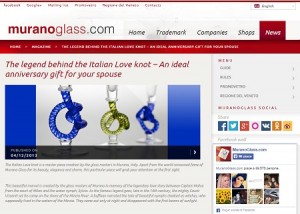The Murano love knot
The Murano love knot
The Murano love knot
-
Hannah
-
Hannah

Venice is known for many things in the cultural world: architecture, music, literature, the classic Commedia dell’arte. But for me, the most striking and beautiful of all the city’s gifts to culture is Murano glass, made exclusively on the islands of that name since the 13th century and wildly popular worldwide for centuries. (The great lover Casanova once told a lover to wear her precious Murano glass beads for a date with him – and only her beads!)
In my novel The Echoes of Love, set in Venice, the vivid colours and elegance of Murano glass are perfect for the backdrop, so I weave in the glass where I can in setting descriptions:
… a golden glow from enormous Murano chandeliers… an amber Murano glass lampadario which hung from a chain of plump, clear glass globules… scalloped Murano glass sconces, shaped like shells, diffusing upwards their mellow light… enormous white Murano glass chandeliers… a beautiful Murano glass vase with a tasteful flower arrangement…
Murano glass makers create all manner of beautiful objects, from vases to chandeliers, pendants to paperweights. But one of their most iconic pieces is the love knot – beautifully sculpted interwoven rods of glass fused together to look like a knot.
Variations on the theme exist. Here’s a popular example from the Murano Net original Venetian glass company (if you get a chance, take a look at their website – there are some beautiful gift ideas for Christmas).
But the Murano Glass company interprets the knot more literally, as illustrated on this page:
 Whatever the style, the Murano knot symbolises love. The roots of the symbolism are to be found in legend:
Whatever the style, the Murano knot symbolises love. The roots of the symbolism are to be found in legend:
In the 14th century, the Count GianGaleazzi Visconti had set up camp with his troops at Valeggio on the banks of the Mincio River, but there was little sleep to be had, for a group of witches descended on them at night, taunting them, threatening them. The men were deeply afraid, and only one dared confront them: Captain Malco. He managed to catch one of the witches, and her cloak fell loose and revealed her true nature: she was a water nymph, a magical creature who lived in the river and could walk on land in the night hours only.
For Captain Malco and the nymph, Sylvia, it was love at first sight. They spent the night together, but with the first rays of the dawning sun, Sylvia vanished. She left behind a symbol of their eternal love: a knot in Malco’s handkerchief.
That evening, a group of young women came to dance for the Count Visconti and his cousin, Isabella. Malco was watching the dancers when he recognised his love, Sylvia, among them. But Isabella saw his attraction for Sylvia, and she was jealous, for she loved Malco. She whispered in the ear of the Count, and soon the dance was in uproar: Sylvia was denounced as a witch, and Malco was forced to defend her physically against his own men. Sylvia fled to the river, and Malco was locked in a cell for his deemed treachery.
Salvation, when it came, was from an unlikely source: Isabella, who had been gripped by guilt for her actions. She helped Malco to escape, holding off the guards, and when they finally made it to the river to search for him, there was no sign of the lovers, who had thrown themselves into the river. All that remained was Malco’s handkerchief, tied with a knot to symbolise eternal love: the Nodod’Amore.
To this day, Valeggiosul Mincio celebrates the Feast of the Love Knot each June. The townspeople line the Ponte Visconteo bridge with tables and chairs and feast on special knot-shaped tortellini and toast Malco and Sylvia: together forever.
You may be wondering why a knot in a handkerchief has inspired Italians for hundreds of years to make romantic glassware and feast in honour of a legend. What is an eternal knot? Such a knot has existed in legend for thousands of years and beyond the reaches of Italy. It’s one of the Eight Auspicious Signs that are important in Hinduism, Jainism and Buddhism, and it appears in ancient Chinese art and symbolism. The true eternal knot has no beginning and no end, so perfectly symbolising eternity; but of course that’s impossible to achieve with a handkerchief or glass (or pasta!). Still, the very fact that so many people own a Modena love knot and so many people attend the Feast of the Love Knot shows that what the eternal knot symbolises – a love that even death cannot end – resonates deeply within the human consciousness.
